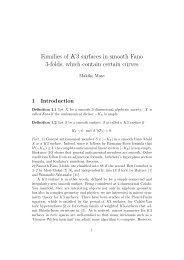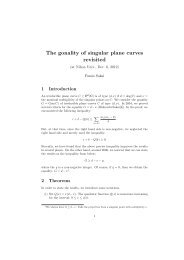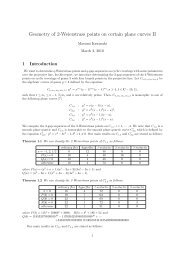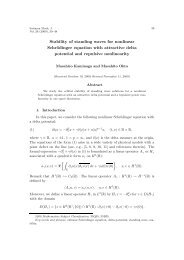Asymptotic distribution of eigenvalues of Hill's equation with ...
Asymptotic distribution of eigenvalues of Hill's equation with ...
Asymptotic distribution of eigenvalues of Hill's equation with ...
Create successful ePaper yourself
Turn your PDF publications into a flip-book with our unique Google optimized e-Paper software.
2 T. Nagasawa and H. OhruiWe improve this result as follows.Theorem 1.2Let Q be a real valued L 1 (R/πZ)-function andThen it holds that∣ √ λ 2n−1 − 2n∣ = o(n −1 ),∫ π0Q(x) dx =0.∣ √ λ 2n − 2n∣ = o(n −1 ) as n →∞.Indeed, we can show the following, from which Theorem 1.2 is easily derived.Theorem 1.3 Let λ be λ 2n−1 or λ 2n ,andput √ λ − 2n = d. Under the sameassumption as in Theorem 1.2, it holds that4nd + d 2 = o(1), (4nd + d 2 ) 2 −|¯Q 4n | 2 = O(n −1 ) as n →∞,where¯Q n = 1 π∫ π0Q(x)e −inx dx.Remark ∫ 1.1 The advantage <strong>of</strong> our theorem is appeared in the caseπQ(x) dx ≠0. Put0Since our <strong>equation</strong> is¯Q(= ¯Q 0 )= 1 π∫ π0Q(x) dx,y ′′ +(λ + ¯Q + ˜Q(x))y =0<strong>with</strong>˜Q(x) =Q(x) − ¯Q.∫ π0˜Q(x) dx =0,Theorem 1.1 implies that the eigenvalue near 2n behaves like√λ + ¯Q − 2n = O(n −1 ) as n →∞.Combining this <strong>with</strong>√λ + ¯Q = √ (λ 1+ ¯Q )2λ + O(λ−2 ) ,we get
ASYMPTOTIC DISTRIBUTION OF EIGENVALUES OF HILL’S EQUATION 3√ ¯Qλ − 2n = −2 √ λ + O(n−1 ).√Both terms in the right hand side are O(n −1 ), and therefore we know onlyλ =2n + O(n −1 ). By using Theorem 1.2, we can determine the next termto 2n as√ ¯Qλ =2n −4n + o(n−1 ).Remark 1.2 Under higher regularity <strong>of</strong> Q, the more precise asymptotics havebeen already known. For example, see [6, Theorems 2.12 and 2.13]. The readerscan refer [4, 5, 7] and references cited therein for asymptotic formulae <strong>of</strong><strong>eigenvalues</strong> for Hill’s <strong>equation</strong> <strong>with</strong> discontinuous coefficient.2. On √ λ 2n−1 , √ λ 2n ∼ 2nIn this section we comment on the fact(2.1)√λ2n−1 =2n + o(1),√λ2n =2n + o(1) as n →∞.This was shown in [6] under the assumptionQ ∈ L ∞ (R/πZ),∫ π0Q(x) dx =0.Borg [2, pp.88ff.] had investigated the problem under Q ∈ L 2 (R/πZ). Here weassert thatTheorem 2.1The asymptotics (2.1) holds underQ ∈ L 1 (R/πZ),∫ π0Q(x) dx =0.Since Hill’s <strong>equation</strong> has very long history, we find about 600 papers onMathSciNet, some <strong>of</strong> them are not easy to access now. The authors could notstudy all <strong>of</strong> them, and are not sure whether the above theorem has been alreadyknown or not. Even if it is not new, they would like to give the pro<strong>of</strong> here forthe sake <strong>of</strong> completeness. Since it is almost parallel <strong>with</strong> that in [6], we mentiononly its outline.Pro<strong>of</strong>.Let y 1 (·,λ)andy 2 (·,λ) be solutions <strong>of</strong> (1.1) satisfying(2.2)y 1 (0,λ)=1,y ′ 1(0,λ)=0,
4 T. Nagasawa and H. Ohrui(2.3)Puty 2 (0,λ)=0,y ′ 2(0,λ)=1.Δ(λ) =y 1 (π, λ)+y 2 ′ (π, λ),then λ is an eigenvalue if and only if Δ(λ) = 2 ([6, 3]). Putθ(λ) =−Δ(λ)+22(1 − cos π √ λ) .Since both numerator and denominator are analytic in λ, in order to show (2.1)we show∫(2.4)1 dlog θ(λ) dλ =02πi C ndλfor a closed curve C n ⊂ C containing{λ ∈ C ||λ| ≦ (2n +1) 2 ,λ∈ R}in its interior, provided n is sufficient large. It is easy to see1θ(λ) − 1=2(1 − cos π √ λ)∫ π0Y (x, λ)Q(x) dx,whereTakeY (x, λ) = sin √ λ(π − x){√ y 1 (x, λ)+ cos √ }λ(π − x) y 2 (x, λ).λC n ={λ ∈ C ∣ √ }λ ∈ C 1,n ∪ C 2,n ∪ C 3,n ,whereC 1,n ={ξ − i(2n +1)∈ C | 0 ≦ ξ ≦ 2n +1},C 2,n ={2n +1+iη ∈ C ||η| ≦ 2n +1},C 3,n ={ξ + i(2n +1)∈ C | 2n +1≧ ξ ≧ 0}.From now on λ is on C n .Thenwehave2e −π|I√ λ| ( 1 − cos π √ )λ =1+o(1) as n →∞.Therefore we know(2.5)providedθ(λ) − 1=o(1) as n →∞
(2.6)ASYMPTOTIC DISTRIBUTION OF EIGENVALUES OF HILL’S EQUATION 5∫ π0( )Y (x, λ)Q(x) dx = o e π|I√ λ|as n →∞holds. (2.5) implies (2.4) for large n. Thus what we should show is (2.6).By successive approximation, the functions y i are given byy i (x, λ) =∞∑j=0y i,j (x, λ) =−√ 1 ∫ xλWe can prove by inductiony i,j (x, λ), y 1,0 (x, λ) =cos √ λx, y 2,0 (x, λ) = sin √ λx√λ,0{sin √ }λ(x − x 1 ) Q(x 1 )y i,j−1 (x 1 ,λ) dx 1 (j ≧ 1).|y i,j (x, λ)| ≦ e|I√ λ|x(∫ x) jj! ∣ √ λ∣ i+j−1 |Q(x 1 )| dx 10for x ≧ 0. It follows from this thatfor every λ ∈ C n . Therefore∫ π0∞∑y i,j (x, λ) converges uniformly in x ∈ [0,π]j=0Y (x, λ)Q(x) dx =∞∑j=0∫ π0Y j (x, λ)Q(x) dxholds, whereY j (x, λ) = sin √ λ(π − x){√ y 1,j (x, λ)+ cos √ }λ(π − x) y 2,j (x, λ).λSince Y 0 is independent <strong>of</strong> x,∫ π0Y 0 (x, λ)Q(x) dx =0.From above estimates we get∫ πλ| ∣ Y j (x, λ)Q(x) dx∣ ≦ 2eπ|I√ ‖Q‖j+1L 10(j +1)! ∣ √ λ∣ j+1for j ≧ 1. Hereafter L p means L p (0,π). Consequently⎧ ⎛ ⎞⎫∫ π⎨∣ Y (x, λ)Q(x) dx∣ ≦ λ|2eπ|I√0⎩ exp ⎝ ‖Q‖ L1∣ √ ⎠ − 1 − ‖Q‖ ⎬L 1λ∣∣ √ λ∣⎭ ,and (2.6) follows.□
6 T. Nagasawa and H. Ohrui3. Pro<strong>of</strong> <strong>of</strong> Theorem 1.3In this section λ is λ 2n−1 or λ 2n , and put√λ − 2n = d.The functions y i satisfyy i ′′ +(2n) 2 y i = −(4nd + d 2 + Q(x))y i .Taking their initial conditions into account, we havesin 2nx(3.1)y 1 =cos2nx + Ky 1 , y 2 = + Ky 2 ,2nwhere K is a bounded operator from L ∞ (0,π) into itself defined by(Ky)(x) =− 1 ∫ x{sin 2n(x − x 1 )}(4nd + d 2 + Q(x 1 ))y(x 1 ) dx 1 .2n 0Since d = o(1) as n →∞,itiseasytosee‖K‖ L∞ →L ∞ ≦ 1 {π|4nd + d 2 }| + ‖Q‖ L 1 = o(1).2nFor n so large that ‖K‖ L∞ →L ∞‖y 1 ‖ L ∞ ≦The derivative <strong>of</strong> y 2 isy ′ 2 =cos2nx −< 1, we have11 −‖K‖ L∞ →L ∞ , ‖y 2 ‖ L ∞ ≦∫ x0Therefore the condition Δ(λ) =2isequivalentto∫ π012n(1 −‖K‖ L∞ →L ∞).{cos 2n(x − x 1 )} (4nd + d 2 + Q(x 1 ))y 2 (x 1 ) dx 1 .U n (x)(4nd + d 2 + Q(x)) dx =0,wheresin 2nxU n (x) =2ny 1(x) − (cos 2nx) y 2 (x).Putting (3.1) into this twice, we havesin 2nxU n (x) =2n(Ky 1)(x) − (cos 2nx)(Ky 2 )(x)= − 1 ∫ x{sin 24n 2 2n(x − x 1 ) } (4nd + d 2 + Q(x 1 )) dx 1+0sin 2nx2n(K2 y 1 )(x) − (cos 2nx)(K 2 y 2 )(x).
ASYMPTOTIC DISTRIBUTION OF EIGENVALUES OF HILL’S EQUATION 7Therefore it holds that0=∫ π0= − 14n 2 ∫ π+∫ π0U n (x)(4nd + d 2 + Q(x)) dx0It is easy to see∫ x0{ sin 2nx2nUsing the condition{sin 2 2n(x − x 1 ) } (4nd + d 2 + Q(x))(4nd + d 2 + Q(x 1 )) dx 1 dx}(K2 y 1 )(x) − (cos 2nx)(K 2 y 2 )(x) (4nd + d 2 + Q(x)) dx.∫ π ∫ x0∫ π0∫ π ∫ x0sin 2 2n(x − x 1 ) dx 1 dx = π24 .Q(x) dx =0,wehave{sin 2 2n(x − x 1 ) } (Q(x 1 )+Q(x)) dx 1 dx =0,00∫ π ∫ xHence d satisfies∣ (4nd + d 2 ) 2 −|¯Q 4n | 2∣ ∣=16n 2∣ π 20∫ π00{sin 2 2n(x − x 1 ) } Q(x 1 )Q(x) dx 1 dx = − π24 | ¯Q 4n | 2 .{ }sin 2nx2n(K2 y 1 )(x) − (cos 2nx)(K 2 y 2 )(x) (4nd + d 2 + Q(x)) dx∣(≦ 16n2‖y1 ‖ L ∞π 2 ‖K‖2 L ∞ →L ∞ 2n≦ 16(π|4nd + d 2 | + ‖Q‖ L 1nπ 2 1 −‖K‖ L ∞ →L ∞≦ C ( )π|4nd + d 2 | + ‖Q‖ L 1 {(4nd + d 2 ) 2 +1 } .n(3.2)Since we have already known d = o(1), it holds) 3(π|4nd+ ‖y 2 ‖ L ∞)+ d 2 )| + ‖Q‖ L 1π|4nd + d 2 | + ‖Q‖ L 1 = o(n).Combining this and ¯Q 4n = o(1) (by Riemann-Lebesgue’s Lemma) <strong>with</strong> (3.2), weobtain the assertion <strong>of</strong> Theorem 1.3□
8 T. Nagasawa and H. OhruiReferences[ 1 ] Borg, G., Über die Stabilität gewisser Klassen von linearen Differentialgleichungen, Ark.Mat. Astr. Fys. 31A (1) (1944), 1–3.[ 2 ] Borg, G., Eine Umkehrung der Strum-Liouvilleschen Eigenwertaufgabe. Bestimmungder Differentialgleichung durch die Eigenwerte, Acta Math. 78 (1946), 1–96.[ 3 ] Coddington, E. A. & N. Levinson, “Theory <strong>of</strong> Ordinary Differential Equations”,McGraw-Hill, New York, 1955.[ 4 ] Karaca, I. Y., On Hill’s <strong>equation</strong> <strong>with</strong> a discontinuous coefficient, Int.J.Math.Math.Sci. 25 (2003), 1599–1614.[ 5 ] Karaca, I. Y., <strong>Asymptotic</strong> formulas for <strong>eigenvalues</strong> <strong>of</strong> a Hill’s <strong>equation</strong> <strong>with</strong> piecewiseconstant coefficient, Math.Proc.R.Ir.Acad.109 (1) (2009), 19–34.[ 6 ] Mugnus, W. & S. Winkler, “Hill’s Equation”, Interscience Tracts Pure Appl. Math. 20,Interscience Publ., New York · London · Sydney, 1966.[ 7 ] Yaslan, I. & G. S. Guseinov, On Hill’s <strong>equation</strong> <strong>with</strong> piecewise constant coefficient, TurkishJ. Math. 21 (4) (1997), 461–474.Takeyuki NagasawaHirotaka OhruiDepartment <strong>of</strong> MathematicsGraduate School <strong>of</strong> Science and EngineeringSaitama University255 Shimo-OkuboSakura-ku, Saitama 338-8570, Japane-mail: tnagasaw@rimath.saitama-u.ac.jps08mm101@mail.saitama-u.ac.jp







